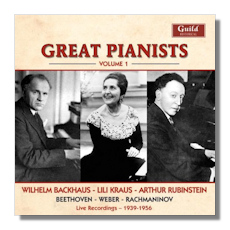
The Internet's Premier Classical Music Source
Related Links
-
Beethoven Reviews
Rachmaninoff Reviews
Weber Reviews - Latest Reviews
- More Reviews
-
By Composer
-
Collections
DVD & Blu-ray
Books
Concert Reviews
Articles/Interviews
Software
Audio
Search Amazon
Recommended Links
Site News
 CD Review
CD Review
Great Pianists, Volume 1

- Ludwig van Beethoven:
- Piano Concerto #4 in G Major, Op. 58
- Carl Maria von Weber::
- Konzertstück for Piano & Orchestra in F Major, Op. 79 *
- Sergei Rachmaninoff::
- Rhapsody on a Theme by Paganini, Op. 43 **
Wilhelm Backhaus, piano
* Lili Kraus, piano
** Arthur Rubinstein, piano
New York Philharmonic Orchestra/Guido Cantelli
* Concertgebouw Orchestra/Pierre Monteux
** New York Philharmonic Orchestra/Victor de Sabata
Live recordings, 1939-1956
Guild GHCD2349
This curious hodgepodge that is Guild's "Great Pianists, Volume 1" contains three very interesting performances. Although none of the repertoire here is groundbreaking, and can mostly be found in superior studio sound, I still find much to admire in these concert recordings. I mean no disrespect to the pianists when I say that in two cases, the conductor is arguably more important than the soloist.
While Wilhelm Backhaus' elegant Beethoven Fourth Concerto can arguably be heard to better effect on Decca (and at least twice), he and Cantelli successfully collaborate in this 1956 concert . According to EMI's "Icon" set, this was not a happy meeting for conductor and orchestra, with Cantelli pledging not to return to the Philharmonic. Incidentally, his tragic death later in 1956 would make this threat a reality. Still, the musicians of the New York Philharmonic play wonderfully, with Cantelli etching a firm orchestral framework. Most impressive for me is the taut and well-argued slow movement, but Backhaus plays very well throughout. The sound is passable and tells us everything we want to know about this particular meeting. The once customary applause following the first movement is included. While I cannot recommend this as a reference Fourth – even in 1956 there were superior choices in the studio – I can urge fans of Backhaus to sample this more urgent, spontaneous reading as compared to his studio recordings.
Lili Kraus is largely remembered by ardent fans of the piano, but she was a major artist for several labels. This 1939 outing with Monteux in obviously dated sound seems out of place after the mid-fifties Beethoven. It does add a work to my collection I did not previously have; this writer hopes that it does more for you than that. The war-era Concertgebouw plays with distinction, while the always reliable Pierre Monteux is also in fine form. This was last found on Audiophile Classics and is horrendously expensive, so anyone who is interested in this particular occasion should know that this is by far the most economical way to acquire it.
The program ends with a wonderful account of the Rachmaninoff Rhapsody, played by a vintage Arthur Rubinstein. His partner is the hugely talented and regrettably elusive Victor de Sabata. Sabata hated making recordings and his reputation was built almost entirely in the opera house. The New York Philharmonic was not yet the powerhouse orchestra it would become by the end of the decade, but they supply their customary energy. Sabata proves just as excitable, drenching the work in dark colors and bringing out plenty of tension. The recorded sound turns harsh whenever things get loud, but otherwise the sparkling pianistic fireworks are everywhere. Rubinstein's stereo recording with Reiner is not so much surpassed here as supplemented. The Chicago players under Reiner are infinitely more beautiful than the New Yorkers of 1953, but the pianist is unquestionably more spontaneous and daring in front of a live audience. Despite the sonic and orchestral imperfections, I can't imagine anyone not being excited by this whirlwind of a performance. Really, the whole disc is a must for anyone who cares about the piano.
Copyright © 2015, Brian Wigman





















